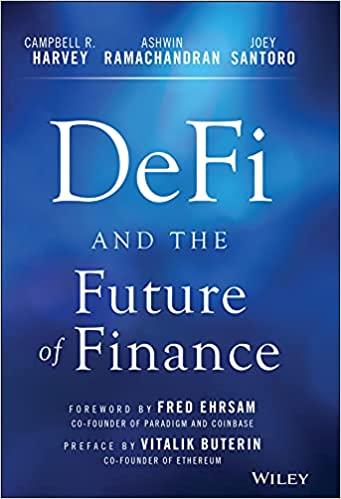1. (a) What is the federal funds rate? (b) What is the federal funds target rate? (c) What is federal funds effective rate? (d) Provide
1. (a) What is the federal funds rate? (b) What is the federal funds target rate? (c) What is federal funds effective rate? (d) Provide a brief explanation of Taylor Rule. (e) The FOMC uses the open market operation to ensure that the effective federal funds rate fluctuates closely around the target. What is the current level of the effective federal funds rate? (f) The FOMC usually decides on whether or not to change the target federal funds rate during the pre-scheduled FOMC meetings. What is your opinion on whether or not the FOMC should raise the target federal funds rate at the coming January meeting and why?
2.
(a) The portfolio manager of a tax-exempt fund is considering investing $500,000 in a debt instrument that pays an annual interest rate of 5.7% for four years (annual compounding). At the end of four years, the portfolio manager plans to reinvest the proceeds for three more years and expects that for the three-year period, an annual interest rate of 7.2% can be earned (annual compounding). What is the future value of this investment? (b) Suppose that the portfolio manager in part a has the opportunity to invest the $500,000 for seven years in a debt obligation that promises to pay an annual interest rate of 6.1% compounded semiannually. Is this investment alternative more attractive than the one in part a? 3. Calculate for each of the following bonds the price per $1,000 of par value assuming semiannual coupon payments.
| Bond | coupon rate % | years to maturity | required yield % |
| A | 8 | 10 | 6 |
| B | 8 | 10 | 8 |
| C | 8 | 10 | 10 |
| D | 0 | 10 | 8 |
4. Suppose that you are reviewing a price sheet for bonds and see the following prices (per $1000 par value) reported. You observe what seem to be several errors. Without calculating the price of each bond, indicate which bonds seem to be reported incorrectly, and explain why.
| Bond | Price | Coupon Rate % | required yield % |
| U | 900 | 6 | 9 |
| V | 960 | 9 | 8 |
| W | 1100 | 8 | 6 |
| X | 1050 | 0 | 5 |
| Y | 1070 | 7 | 9 |
| Z | 1000 | 6 | 6 |
5. The Treasury department issued a 10-year bond on January 1, 2015. The par value is $1,000 and the annual coupon rate is 10%. The bond pays two coupons every year, one at the end of June and one at the end of December. The required annual yield is 8%. An investor bought the bond on March 31, 2015. What is the price that he should pay for the bond? (Assume a month has 30 days)
6. Calculate for each of the following bonds the yield to maturity. The par value is $1,000. Assume semiannual coupon payments.
| Bond | Coupon Rate % | years to maturity | Price ($) |
| A | 8 | 10 | 1000 |
| B | 8 | 10 | 1200 |
| C | 8 | 10 | 800 |
| D | 0 | 10 | 600 |
7. Suppose that an investor with a five-year investment horizon is considering purchasing a seven-year 9% (annual rate) coupon bond selling at par. The investor expects that he can reinvest the coupon payments at an annual interest rate of 9.4% and that at the end of the investment horizon two-year bonds will be selling to offer a yield to maturity of 11.2%. What is the total return for this bond? Assume semiannual coupon payments.
8. Consider the following portfolio:
| Bond | Market Value | Macaulay duration (years) |
| W | $13 Million | 2 |
| X | $27 Million | 7 |
| Y | $60 Million | 8 |
| Z | $40 Million | 14 |
(a) What is the portfolios Macaulay duration?
(b) The annual yield to maturity is 10%. What is the portfolios modified duration? Assume semi-annual coupon payment.
(c) When the yield to maturity decreases to 9.9%, should the value of the portfolio increase or decrease? Use the modified duration to calculate the approximate percentage change in the value of the portfolio.
9. Calculate the requested measures in parts (a) through (d) for bonds A and B (assume that each bond pays interest semiannually).
| Bond A | Bond B | |
| Coupon | 8% | 9% |
| Yield to Maturity | 8% | 8% |
| Maturity (years) | 2 | 5 |
| Par | $100.00 | $100.00 |
| Price | $100.00 | $104.55 |
(a) What is the price value of a basis point for bonds A and B?
(b) Compute the Macaulay durations for the two bonds.
(c) Compute the modified duration for the two bonds.
(d) Compute the convexity measure for both bonds A and B
(e) An investor bought one share of bond A and one share of bond B. What is the Macaulay duration of the investors bond portfolio?
Step by Step Solution
There are 3 Steps involved in it
Step: 1

See step-by-step solutions with expert insights and AI powered tools for academic success
Step: 2

Step: 3

Ace Your Homework with AI
Get the answers you need in no time with our AI-driven, step-by-step assistance
Get Started


